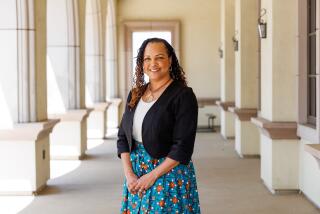Balancing Brain’s Power by Improving Art Skills
A few years ago in Austin, Tex., about 200 scientists and technical workers at IBM’s computer production facility were invited to put down their slide rules and study art with Betty Edwards.
But Edwards is no ordinary art teacher and IBM was not looking for ordinary results.
Big Blue was not interested in producing “designer” computers or more aesthetically pleasing circuit board sketches. The company hired Edwards, a Santa Monica resident and Cal State Long Beach professor of art, because it wanted to balance the brains of its workers.
IBM imported a California art teacher, author of the best-selling “Drawing on the Right Side of the Brain” (J. P. Tarcher) and the recently published “Drawing on the Artist Within” (Simon & Schuster), to gain more creative problem solving from its employees.
The firm was so impressed with the results, it has since sent Edwards to Italy and Belgium to address its European managers. IBM’s Austin computer production facility went on to hire a local art teacher to study with Edwards in Santa Monica and then return to Texas to provide ongoing instruction in Edwards’ techniques. And the Austin branch is bringing Edwards back for more work this fall.
How do you get better problem solving by improving your art skills?
Peaceful Coexistence
According to Edwards and other researchers, the thinking process is greatly enhanced when the left brain hemisphere (which governs analytical, verbal, sequential and logical processes) and the right brain hemisphere (which handles the intuitive, visual, perceptual and imaginative assignments) are both functioning in peaceful coexistence.
In 1968, Nobel Prize-winning Caltech psychobiologist Roger Sperry and his associates discovered that the two sides of the brain process information in fundamentally different ways. They and others found, for instance, that the left brain loves to talk. And that the right brain would rather doodle.
Given the educational system’s emphasis on analytical and verbal training, most people are far more skilled in left brain operations than right, Edwards explained recently, over lunch at Los Angeles International Airport. (She was on her way to another corporate assignment, a series of lectures for Steelcase Inc., a Grand Rapids-based manufacturer of high-styled office furnishings.)
In Edwards’ view, engineers, scientists and technical workers are often so extremely logical and analytical that they’re left-brain dominant--even more so than the rest of our left-brain-oriented society. It’s no wonder, she said, that technically oriented firms such as such as IBM and General Electric are suddenly interested in developing the more creative half of their employees’ brains.
Focus on Innovation
In Edwards’ first book she emphasized that anybody could learn to draw and provided numerous techniques for unlocking those abilities. In the sequel, she focuses on innovation, invention, imagination and creativity.
She provides the reader with exercises on such skills as visually thinking in proportion and perspective, emphasizing that “the visual skills of sighting help the mind to ‘measure’ proportional differences and to put ourselves and our perceptions into the picture as it really exists.”
And Edwards, who received her doctorate from UCLA in art studies, education and the psychology of perception, advocates processes such as visual brainstorming in addition to verbal brainstorming. In this exercise, rough pictures of a problem in relation to its components are drawn rapidly and repeatedly. As she explained, this is an important step in the thinking process, saturating the mind with “words and images relevant to the subject, making all possible connections, fitting together as many puzzle pieces as possible. . . .”
It’s been considerably easier selling these kinds of ideas in 1986 than 1979, when “Drawing on the Right Side of the Brain” was published, Edwards said. “I think the difference is that brain hemisphere work is pretty well known now. There’s not much explaining needed. Lately, there’s been much greater interest among unexpected groups like business people and scientific people, people who back in ’79 might have discounted the notion that the right brain had much to contribute to the solving of basic problems.
“That perception is changing.” In 1979, she added, the attitude of art groups was one of relief--”someone had articulated ideas they had held for a long time.”
Helped Art Teachers
Edwards’ work is now standard fare in art circles. And, according to the author, it has helped art teachers to see themselves as more valuable in the overall development of students. “Art people are now hoping for a stronger position in teaching,” she said. “They want to be viewed not as baby sitters for difficult students or a dumping ground for students with learning disabilities. Rather they want to be seen as respected teachers of cognition.”
If “Drawing on the Right Side of the Brain” was a hit in art circles, it didn’t do badly with the general public either.
Edwards’ first book, which emphasized the virtues of such drawing techniques as copying a picture upside down (to exercise the right brain by tricking the left brain into getting out of the way), sold more than a million copies. It remained on the New York Times’ best-seller list for more than a year, was translated into nine languages and has become a widely used college text. In bookstore lingo, “Drawing on the Right Side of the Brain” is still considered an “evergreen,” a constantly stocked selection for which there is continual, steady demand--seven years after its publication.
Sales Increasing
The sequel, “Drawing on the Artist Within,” which was published in mid-January, sold out its first printing of 60,000 copies in less than a month and is increasing in sales.
“I think this is the book I was trying to write back then (1979) and couldn’t,” Edwards said, with relief ringing in her voice. “It took three years to do this book. . . . This book was hard. It’s hard to spit out in words what is essentially a non-verbal process. It’s still extremely hard to put those ideas into words.”
As she wrote, “I propose that learning to see and draw is a very efficient way to train the visual (right brain) system, just as learning to read and write can efficiently train the verbal (left brain) system. That is not to say that the visual system is better, morally or otherwise, than the verbal system. But the two systems are different. And when trained as equal partners, one mode of thinking enhances the other, and together the two modes can release human creativity.”
Though the state of California is currently funding Edwards’ research institute (to the tune of $54,000 a year at Cal State Long Beach), she doesn’t expect to see the strongest financial support for right-brain equal rights to come from government or the educational system.
“I think the educational push will come from corporations,” she declared, just before leaving to catch her plane. “They’re so interested in getting employees who are good at problem solving that they’re beginning to fund this type of program in the public schools.”






